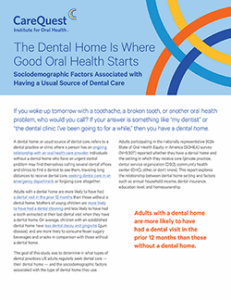Sociodemographic Factors Associated with Having a Usual Source of Dental Care
Seventy-six percent of adults report having a dental home where they receive regular dental care, according to CareQuest Institute’s 2024 State of Oral Health Equity in America survey.
The goal of this visual report, which highlights the key data point, was to determine what types of dental practices US adults use as their dental homes, and the sociodemographic factors associated with the type of dental home they use. According to the report, having a dental home — a dental practice or clinic where a person has an ongoing relationship with an oral health care provider — is associated with regular dental visits and better oral health outcomes for patients, while lack of a dental home can lead to a variety of obstacles to good oral health.
Additional key findings include:
- Adults with dental insurance are more likely to have a dental home (85%) than those without dental insurance (62%).
- The percentage of adults who have a dental home increases with income and age.
- Nearly one-third (32%) of adults aged 18-29 do not have a dental home.
- Younger adults and adults with lower incomes and less education are more likely to say their dental homes are dental service organizations (DSOs) and community health centers (CHCs) than private dental practices.
These findings highlight the need for diverse types of dental homes to support access to care across a range of socioeconomic statuses. For those without dental homes, partnerships between hospital EDs and dental providers could facilitate more appropriate care pathways for dental emergencies and reduce the cost of care.
You may also be interested in:
- State Oral Health Dashboard, an interactive tool showing data for 16 measures of oral health access, costs, and outcomes for every state.
- Out of Pocket: A Snapshot of Adults’ Dental and Medical Care Coverage, a visual report analyzing dental insurance coverage in the US.
- Federal Medicaid Cuts Threaten State Dental Benefits, a publication examining lessons and consequences for states that have eliminated Medicaid adult dental benefits in the past.

